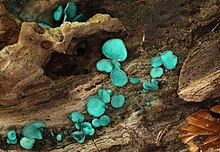Chlorociboria
| Chlorociboria | |
|---|---|

| |
| Chlorociboria sp. | |
| Scientific classification | |
| Kingdom: | |
| Division: | |
| Subdivision: | |
| Class: | |
| Order: | |
| Family: | |
| Genus: | Chlorociboria Seaver ex Ramamurthi, Korf & L.R. Batra
|
| Type species | |
| Chlorociboria aeruginosa (Oeder) Seaver ex C.S. Ramamurthi
| |
| Species | |
|
17, see text | |
Chlorociboria is a genus of fungi within the subphylum Pezizomycetes. The genus includes 17 species.[1]
Two common temperate zone species, Chlorociboria aeruginascens and Chlorociboria aeruginosa, can only reliably be distinguished by microscopic examination. Chlorociboria aeruginosa has larger spores (9–15 µm × 1.5–2.5 µm) and the worm-like cells of the outer surface are rough, unlike the commoner C. aeruginascens, of which the spores are 6–10 µm × 1.5–2 µm.
The hyphae and fruiting bodies of all species make xylindein, a secondary metabolite that stains the substrate wood blue-green, with "green oak" being a valued commodity in woodworking. The blue-green pigmented wood is featured in "Tunbridge ware."
Habit
Blue-green stain is evident year-round, with ascocarp production occurring from summer to fall.
Species
- Chlorociboria aeruginosa
- Chlorociboria aeruginascens
- Chlorociboria albohymenia
- Chlorociboria argentinensis
- Chlorociboria awakinoana
- Chlorociboria campbellensis
- Chlorociboria clavula
- Chlorociboria colubrosa
- Chlorociboria duriligna
- Chlorociboria halonata
- Chlorociboria macrospora
- Chlorociboria omnivirens
- Chlorociboria pardalota
- Chlorociboria poutoensis
- Chlorociboria procera
- Chlorociboria spathulata
- Chlorociboria spiralis
See also
References
- ^ Kirk PM, Cannon PF, Minter DW, Stalpers JA (2008). Dictionary of the Fungi (10th ed.). Wallingford: CABI. p. 137. ISBN 0-85199-826-7.
External links
- Chlorociboria at Index Fungorum
- Mushroom Expert Chlorociboria aeruginascens
- Article: "Separation of Chlorociboria aeruginascens and C. aeruginosa" from the Warwickshire Fungus Survey
